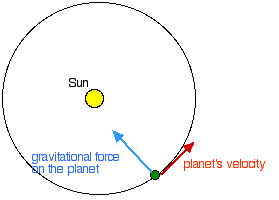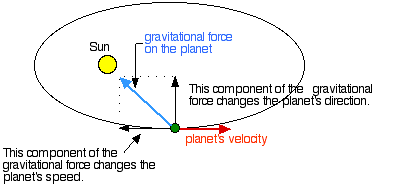Ch 14 - Satellite Motion
Assignment Answers
Ch 14 Review Answers:
- (a) If you drop a ball from rest, it will fall 5 meters
in the first second. (Chapter 2)
d = (1/2)at2 = (1/2)(10 m/s2)(1
s)2 = 5 m
(b) If you throw the ball horizontally instead of just dropping
it, it will still fall 5 meters in the first second. The
ball is a projectile, and the horizontal (constant velocity) and
vertical (free fall) components of the motion are independent.
(Chapter 3)
-
- In a circular orbit, the path of the satellite is parallel to
the Earth's surface.
- The gravitational force doesn't change the speed of a
satellite in circular orbit because the force is always
perpendicular to the direction of motion of the satellite.
Therefore, the force changes the direction of the satellite, but
not its speed.

-
-
- The gravitational force changes the speed of a satellite in
elliptical orbit because there is a component of the force in the
direction of the satellite's motion.

- (a) The speed of a planet is going to be a maximum where
its kinetic energy is maximum. Its kinetic energy will be a
maximum where the planet has the least gravitational potential
energy. The planet has the least gravitational potential energy
when it is closest to the Sun. So, therefore, the planet has its
maximum speed when it is closest to the Sun.
(b) The speed of a planet will be a minimum when the planet is
farthest from the sun, for reasoning similar to part (a).
- Yes, since no energy is added or removed from the Sun + planet
system, its energy is conserved no matter what the shape of the
orbit, so KE + PE = constant.
- The force of gravity does no work on a satellite in circular
orbit since the force is always perpendicular to the planet's
direction of motion. (See the diagram for Review Question #4.) The
gravitational force does do work on a satellite in elliptical
orbit because there is a component of the force in the direction
the satellite moves. (See the diagram for Review Question #7.)
Note that as the satellite is moving away from the Sun, the
gravitational force is doing negative work on the satellite, so
GPE is being stored (KE converting to GPE). As the satellite moves
toward the Sun, the gravitational force does positive work, and
the satellite speeds up (GPE converting to KE). The total work
done by gravity in a complete orbit is zero.
- Refer to Table 14.1 on p. 208 of the text. Since escape speed for Earth is 11.2 km/s, an object fired vertically at 8 km/s would eventually fall back to Earth, but an object fired vertically at 12 km/s would not - it would go into orbit around the Sun. Do you see why?
- (a) In order to leave the solar system, a particle would have to be ejected from the Sun with a speed of 620 km/s. (Refer to Table 14.1 on p. 208 of the text.)
(b) If the particle started at a distance equal to Earth's distance from the Sun, its speed would have to be 42.2 km/s. (Again from Table 14-1.)
- Table 14.1 on p. 208 in the text gives the escape speed for the Moon as 2.4 km/s.
- Yes, a rocket carrying enough fuel could escape from Earth's gravity at any speed. In fact, no rocket launched from Earth has ever reached a speed of 11.2 km/s! Even though escape speed is the popular concept, the really important concept is ENERGY - not speed. (Duh! This is physics, after all.) If the rocket carried useful energy equal to (1/2)mvescape2, (where m is the mass of the rocket and vescape is the escape speed) it would escape from Earth's gravity. This energy doesn't have to be in the form of kinetic energy - rockets carry their energy in the form of chemical potential energy.
Ch 14 Think & Explain Answers
- A satellite can't orbit 5 km above the surface of the Earth
because the Earth's atmosphere would provide an air resistance
force that would slow the satellite down. Since the Moon has no
atmosphere, a satellite can be launched at any altitude - as long
as it is high enough that it doesn't run into a mountain!
- Suppose we put a satellite in circular orbit around the Earth.
The centripetal force needed to keep the satellite in orbit is
supplied by the Earth's gravitational force. If the satellite has
mass m, the Earth has mass M, and the satellite is at a distance r
from the center of the Earth:

This says that the speed of the satellite depends only on the mass
of the Earth, its distance from the center of the Earth, and the
constant G. So:
(a) No, the speed of a satellite does not depend on its mass.
(b) Yes, the speed of a satellite does depend on its height.
(c) Yes, the speed of a satellite does depend on the mass of the
Earth.
-
- The total amount of (net) work done by gravity as a satellite makes a complete orbit is zero. The gravitational force has a component in the direction of the satellite's motion as the satellite moves toward the Sun (or Earth, or whatever). Therefore the work done during the "coming toward" part of the orbit is positive. As the satellite moves away, the gravitational force has a component opposite the satellite's direction of motion, so gravity does negative work during the "moving away" part of the orbit. Since the "coming toward" and "moving away" portions of the orbit are symmetrical, the two works are equal in magnitude and add to zero for a complete orbit. (See the discussion for Ch 14 Review #10.)

- Communications satellites keep the same position relative to
the Earth's surface because they have an orbital period of 24
hours, the same as the Earth. They only appear to be motionless
relative to the Earth, actually, they are moving at high
speeds!
-
-
-
-
-
-
-
-
- (a) The satellite experiences the maximum gravitational force
at point A, since it is closest to the Earth (or whatever that
blue circle represents). Gravitational force is inversely
proportional to distance.
(b) The satellite has its greatest speed at point A. Since it is
closest to the Earth, it has its minimum GPE at A, so it has its
maximum KE there, too. More kinetic energy means more speed.
(c) The satellite has its greatest velocity at point A, since its
speed is maximum there.
(d) The satellite has its maximum momentum at point A, since p =
mv, and it has its maximum velocity at point A.
(e) The satellite has its maximum KE at point A, as discussed in
part (b).
(f) The satellite has its maximum GPE at point C, since
gravitational potential energy increases with distance from
Earth.
(g) The satellite has the same total energy everywhere, since no
energy is being added to or taken away, energy is conserved.
(h) The satellite has its greatest acceleration at point A, since
that is where the maximum force is located, and a = F/m.



